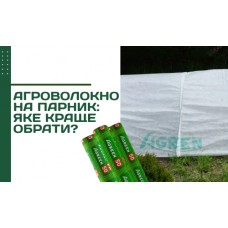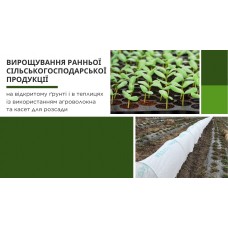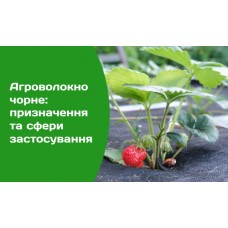White covering agrofibre – all the benefits for growing vegetable and berry crops
White agrofibre is a nonwoven covering material for plants, widely used in agriculture. It serves as an indispensable assistant for both professional farmers and amateur gardeners.
White agrofibre: advantages of use
- provides reliable protection for plants against negative environmental factors (early spring and late autumn frosts, heat, wind, hail);
- creates a physical barrier against pests;
- maintains a stable temperature regime, smoothing out temperature fluctuations;
- prevents moisture evaporation and soil drying, thus reducing the number of waterings;
- simplifies plant care;
- speeds up seed germination;
- increases yield and product quality;
- helps obtain vegetables and berries out of season (early in spring and late in autumn).
White agrofibre creates optimal conditions for plant development. Thanks to its porous, “breathable” structure, air passes freely through the spunbond, ensuring natural ventilation, while the white color promotes the passage of sunlight necessary for photosynthesis. In addition, the porous material allows moisture to pass through and prevents its excessive evaporation.
Types of white agrofibre by density
- Light (17-23 g/m2) – used to cover beds to protect plants from slight frosts (down to -5 °C).
- Medium (30-42 g/m2) – employed for making low tunnels and greenhouses, helping crops withstand more significant frosts (-7-8 °C).
- Dense (50 g/m2) – used to cover perennial plants in winter for frost protection.
Practical use of agrofibre for growing different crops
Under agrofibre, you can grow any vegetables (cucumbers, tomatoes, peppers, eggplants, cabbage, zucchini, radishes, carrots), greens (lettuce, spinach), and berry crops (strawberries, raspberries, blackberries, blueberries, bilberries).
Fragile plants (lettuce, spinach) are covered with a lightweight spunbond so as not to damage them. Over tall plants (tomatoes, peppers, eggplants), it is advisable to install hoops and stretch a medium-density fabric over them.
For berry crops, it is recommended to combine white and black agrofibre. The covering material creates an optimal microclimate, while the black material serves to mulch the soil and protect the berries from weeds.
When growing grapes, the vine is wrapped with dense covering agrofibre for the winter to protect it from temperature fluctuations and icy conditions.
Growing potatoes
Planting potatoes under agrofibre is done in the southern regions in March, and in the northern regions and central Ukraine – in April. It is important for the soil to warm up to +6 °C.
Sprouted tubers are planted into pre-prepared soil. Then the beds are covered with spunbond with a density of 23 or 30 g/m2. You can install hoops and stretch the material over them.
The agrofibre is removed when the threat of frost has passed or before harvesting.
Growing potatoes under agrofibre:
- protects plants from spring frosts;
- increases soil temperature by 4-6 degrees;
- speeds up tuber germination and sprout emergence by 7-10 days;
- protects against Colorado potato beetles and other pests;
- boosts yield by 10-15%;
- helps obtain an ultra-early harvest and significant profit – you can sell new potatoes as early as the beginning of May, when market prices are at their highest.
Growing cucumbers
Cucumbers belong to heat-loving crops. They are especially sensitive to drops in temperature – even without frosts, they can die or experience a substantial slowdown in growth.
Planting cucumbers under agrofibre:
- ensures fast and uniform sprout emergence;
- protects delicate shoots from cold and drafts;
- reduces the risk of diseases;
- allows you to get the first cucumbers 10-20 days earlier;
- helps increase yield by 20-30%.
Lightweight spunbond is used to cover the beds or a medium-density material is stretched over a frame.
Growing peppers
Peppers are another heat-loving crop that does not tolerate temperature fluctuations well and is very demanding on environmental conditions.
If peppers are planted under agrofibre, you can:
- protect the crop from frosts and temperature swings;
- create ideal conditions for growth and development;
- retain soil moisture;
- prevent sunburn;
- speed up fruit ripening;
- extend the fruiting period.
Spunbond with a density of 23 g/m2 can be laid directly on the plants. A denser material is fixed on hoops so as not to break the fragile stems.
Growing strawberries
Strawberries under agrofibre produce a harvest 10-14 days earlier. In addition, yields increase by 25-35%.
You can use white agrofibre for strawberries at different times of the year:
- in spring – it retains heat, stimulates early flowering, and speeds up berry ripening;
- in summer – it prevents moisture evaporation, protects against sunburn, and improves fruit quality;
- in autumn – it shields against early frosts and prolongs the growing season;
- in winter – it saves plants from freezing temperatures.
Agrofibre in greenhouses and low tunnels
A low tunnel or greenhouse made of agrofibre has several advantages over structures covered with film:
- creates a favorable microclimate;
- retains heat well, protecting against frosts;
- ensures high-quality air circulation, which promotes healthy seedling growth and prevents overheating of plants;
- does not accumulate condensation, which minimizes the risk of fungal diseases.
To achieve the expected results, follow these basic recommendations:
- when covering plants, do not stretch the material too tightly – leave some slack for growth;
- to fix the edges, it is advisable to use special pegs for agrofibre, or metal or plastic pins;
- on hoops, the material is secured with staples or string;
- you can water the plants directly through the spunbond;
- if you use the covering permanently, remove the material on sunny days for pollination of flowers;
- after the season ends, store the agrofibre in a dry, dark place.
Agrofibre ™Agreen is made of eco-friendly material and meets all stated characteristics and quality standards. It is safe for plants, animals, and people, and does not harm the environment. The spunbond contains UV stabilizers, enabling it to last for 3-4 seasons.
By purchasing high-quality agrofibre from the manufacturer and using it correctly, you can recoup your investment within the first season, make your work easier, reduce expenses, obtain a quality early harvest, and achieve a stable income.
Related Articles
Agricultural Fabric for Greenhouses: How to Choose the Best Option
The question of which agricultural fabric is best for greenhouses is relevant for both novice and experienced gardeners. The material's type determines its specific features. Before setting up a greenhouse, it's essential to define your goals and select agricultural fabric with the most suitable characteristics. Let’s explore its features in more detail.
Black agrotextile: purpose and areas of application
Black agrotextile is one of the most popular materials used for soil mulching—an agrotechnical technique that involves covering the land to improve soil quality and create optimal conditions for plant development.






